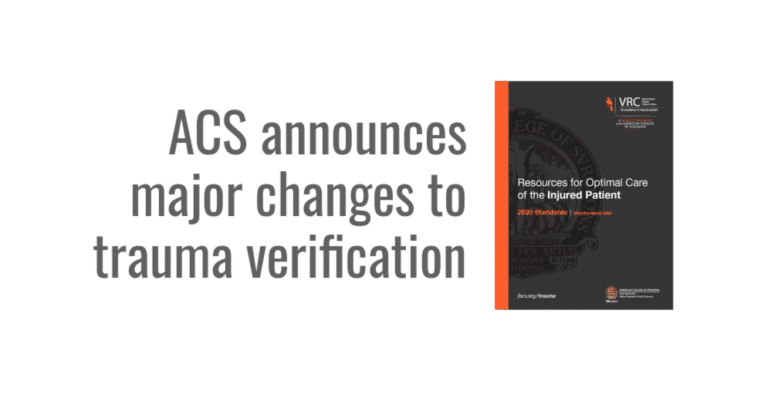The American College of Surgeons (ACS) has announced that it has developed a process for conducting trauma center verification site visits in a virtual format. ACS leaders also reported that they will soon finalize major revisions to the college’s trauma center standards.
The upcoming changes were previewed during the 2020 TQIP Annual Scientific Meeting and Training, which took place online December 7-10.
During the “New Approach to Verification” session, leaders of the Verification Review Committee (VRC) explained the virtual site visit process and outlined several changes to trauma center requirements.
Virtual site visits will involve new roles and processes
After the ACS extended all verification periods for one year in March 2020, the VRC developed plans to restructure the review process for remote technology. The VRC then piloted a virtual site visit process at three U.S. trauma centers.
Centers scheduled for a site visit in 2021 will be reviewed remotely using the new process. After pandemic restrictions ease, the ACS may adopt some combination of remote and in-person visits for future verification reviews. (To learn more, read ACS: Future role likely for both virtual and in-person trauma site visits.)
Correction: An earlier version of this article incorrectly stated that the ACS had permanently discontinued in-person site visits for trauma center verification and that all future visits would be virtual. In fact, the ACS has no plans to completely discontinue in-person site reviews.
According to Nilda Garcia, MD, FACS, vice chair of the VRC, the virtual review process includes several important modifications:
New support roles. To facilitate the virtual review process, trauma centers will need to assign staff to perform two new roles — site visit coordinator and site visit navigator.

Vice Chair, ACS Verification Review Committee
The site visit coordinator will be responsible for tasks such as setting up the virtual communication platform and making sure all liaisons are logged in at the right time. According to Dr. Garcia, the site visit coordinator should not be the trauma program manager or the trauma medical director.
The navigators will help ACS reviewers access EMR records, PI documentation and imaging as needed. One navigator will be assigned to each reviewer. Dr. Garcia clarified that the site visit coordinator cannot also act as a navigator. The navigator should be familiar with the trauma program as well as the structure and content of patient charts.
Pre-review call. A conference call will take place about two weeks before a scheduled virtual visit. This call will allow the trauma center team to meet their reviewers, discuss expectations and ask questions about the visit agenda. The call will also give participants the chance to test the technical functionality of the virtual review platform. Pre-review call participants should include the trauma medical director, the trauma program manager, trauma registrars, the site visit coordinator and the navigators.
Pre-selected chart review. In the pilot study, reviewers found it difficult to perform a complete chart review in an entirely virtual format. As a result, the VRC decided to restructure the process so that ACS reviewers have an opportunity to begin their chart review several days before the visit. The trauma program will first provide a list of review-eligible charts to ACS reviewers. The reviewers will then select the charts they want to examine. According to Dr. Garcia, this process allows reviewers to prepare ahead of time for the medical record review and come to the session with relevant questions.
Document package requirements. The VRC will require trauma programs to package all assessment documents in PDF format. In addition, medical records should be delivered via a HIPAA-compliant method. Medical records should include the registry profile, relevant PI documentation, and any related clinical practice guidelines or protocols. Other items for inclusion could include ED documentation, H&P documentation, operative notes and consultation discharge summaries.
Review dinner replaced by review meeting. In place of the traditional review dinner, the virtual visit will now include a review meeting. Participants will take part in the meeting via the virtual communication platform. “We learned … not to perform this meeting where the trauma site had everyone in one room with microphones,” Dr. Garcia said. “That made it very difficult for the reviewer to know who was speaking and what role they actually had in the trauma program.”
Virtual tour. Under the virtual review process, the facility tour will be conducted by remote video. A trauma program staff member will use a smartphone, tablet or other video-enabled device to show reviewers different areas of the hospital and allow them to interact with hospital staff.
According to Dr. Garcia, the pilot study also tested a prerecorded hospital tour, but both hospital staff and ACS reviewers preferred the live tour format. “This allowed the actual reviewer to navigate where they wanted to go next in the hospital,” she said. “It also allowed for impromptu questioning of staff members that were introduced as the tour was going along.”
Trauma center standards will be clearer and more measurable
A major goal of the new revision was to make trauma center verification standards more concrete and measurable.

Consultant and Past Chair, ACS Verification Review Committee
“As you know, in the previous versions we’ve had to come out with a clarification document,” said Daniel Margulies, MD, FACS, past chair of the VRC and current committee consultant. “It was our goal to end this resource update without having any need for a clarification document — we should be clear from the beginning.”
According to Dr. Margulies, work groups reviewed the Orange Book for vague words such as appropriate, timely and acceptable. They then attempted to define these requirements in measurable terms. For example, where the current standards require “sufficient” resources, the work groups tried to define how many is sufficient.
Trauma center verification standards have also been reorganized. Previously, standards were categorized by function. Under the new requirements, the verification standards will be grouped in nine categories:
- Institutional Administrative Commitment
- Program Scope and Governance
- Facilities and Equipment Resources
- Personnel and Services Resources
- Patient Care: Expectations and Protocols
- Data Surveillance & Systems
- Quality Improvement
- Education: Professional and Community Outreach
- Research: Basic and Clinical Trials
For example, PI program standards will reside in the “Quality Improvement” category. Trauma registry standards will be covered under “Data Surveillance & Systems.”
According to Dr. Margulies, these nine categories are aligned with the structure of other ACS quality programs. The new organization is more user-friendly because related standards are grouped together.
As part of the reorganization, the total number of standards has been reduced by two-thirds. While the Orange Book contained 387 standards, the new standards book will include only 122. (The final number is subject to revision.)
“Some of the standards are combined, others were eliminated,” Dr. Margulies said. “But a fewer number of standards means it’s more clear for the reviewers to verify.”
TQIP data will play a greater role in site visits
Under the new survey process, the site visit agenda will include scheduled time for a review of the trauma center’s Trauma Quality Improvement Program (TQIP) report. ACS reviewers will have access to the full report prior to the site visit.
Under the previous site visit system, ACS reviewers received a high-level summary of a center’s TQIP results. This summary report provided only a broad overview of trauma center performance.
Under the new system, ACS reviewers will receive the trauma center’s full TQIP report ahead of time. During the site visit, this will allow reviewers to skip open-ended questions and focus immediately on potential issues.

Medical Director, ACS Trauma Quality Programs
“So the discussion is going to be focused on: What have you learned from your report and how are you acting on it?” said Avery Nathens, MD, MPH, PhD, medical director of ACS trauma quality programs.
“The expectation is your reviewers will have seen the report in advance of the visit and you’ll spend some time — not a lot of time, but some time — on a focused discussion of your TQIP report with the reviewers,” he said.
According to Dr. Nathens, trauma program leaders should prepare to talk about their TQIP report in detail during the site visit. “Be prepared to discuss any issues you found and how you are attempting to resolve them,” he said. “There isn’t an expectation that you’ve actually resolved the issues, but just that you’re working in the right direction.”
In some circumstances, trauma program leaders could use their TQIP report to “push back” against the selection bias that might be present in a chart review.
“The reviewers can ask what you’re doing with your data,” Dr. Nathens said. “But you can also use your data to say, ‘We actually don’t have a problem.’ So it works both ways.”
During the conference Q&A session, one attendee asked, “Will my verification status be impacted if I am a high outlier on my TQIP benchmark report?”
“The answer to that is no,” Dr. Nathens said. “We have always taken the position that if you’re a high outlier, the expectation is that you’re working on solving the problem — you’re digging into your reports, you’re digging into your data, to try to understand where the problem might be — and that if you’ve identified the problem, you’re working toward a solution.”
“There might be an issue if you’re a high outlier and you haven’t attempted to dig into it or attempted to solve it,” Dr. Nathens said, “but this is just a question of loop closure.”
New staffing and education requirements

Chair, ACS Verification Review Committee
The new standards will also introduce concrete requirements for trauma program staffing and education. William Marx, DO, FACS, current chair of the VRC, described three key changes:
Trauma PI coordinator staffing requirement. Under the new standards, trauma centers with more than 500 patients that meet National Trauma Data Standard (NTDS) inclusion criteria per year must have a dedicated 0.5 FTE trauma PI coordinator. Trauma centers with more than 1,000 NTDS-eligible patients per year must have a dedicated 1.0 FTE trauma PI coordinator. (Under the Orange Book, there was no staffing requirement for PI coordinators.)
Trauma registrar staffing requirement. The new standards also require trauma programs to have 0.5 FTE trauma registrars for every 200 to 300 patients in the trauma registry. (Under the Orange Book, the requirement was one FTE registrar for each 500 to 750 patients.)
Trauma registrar education requirement. The new standards require staff with a trauma registry role to participate in several educational courses:
- The most recent version of the Abbreviated Injury Scale (AIS) Training Course from the AAAM (with pass)
- A trauma registry course that covers abstraction, data management, reports and report analysis, data validation and HIPAA requirements
- An ICD-10 course or an ICD-10 refresher course every 5 years
Any registrars who have not fulfilled these requirements must do so within 18 months of their hire date or within 18 months of the effective date of the new standards, whichever is more recent.
The new trauma registry education requirements apply to Adult Level I, Level II and Level III trauma centers and Pediatric Level I and Level II trauma centers.
Other changes to trauma center standards
The new verification standards will also include several adjustments to specific requirements.
For example, under the Orange Book, Pediatric Level II trauma centers were required to admit 100 or more injured patients under age 15 per year. This requirement has been eliminated in the new standards.
In addition, the new standards will include adjusted requirements for anesthesia availability, access to angiography, neurosurgery response and orthopedic surgery response.
Timeline for rollout of the 2020 Standards
According to Dr. Margulies, the new standards were approved by the ACS Committee on Trauma in November 2020. The contents of the standards book and related compliance measures will be completed in February 2021. ACS expects to release the new book in mid 2021.
ACS reviewers and trauma center staff will receive training on the new standards following release of the new book. The new platform for administering site visits and PRQs will be launched this year.
Update: An earlier version of this article stated that the new standards would be released in March 2021, training would be delivered in spring 2021 and the new platform would be launched in summer 2021. After consulting with the ACS, these statements have been revised as shown.
“We are not going to start reviewing on the new standards until sometime in 2022, when everyone has had an opportunity to implement them and the reviewers have been trained on how to verify,” Dr. Margulies said.
According to Dr. Garcia, VRC staff will contact trauma centers to schedule their upcoming verification visits. Centers that received a verification extension expiring in 2021 should expect a call soon.

